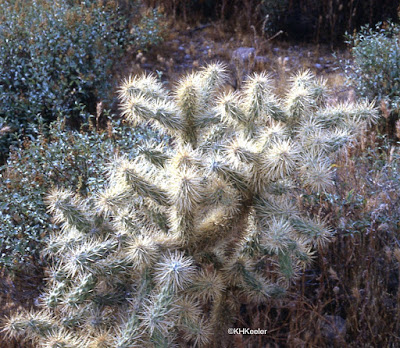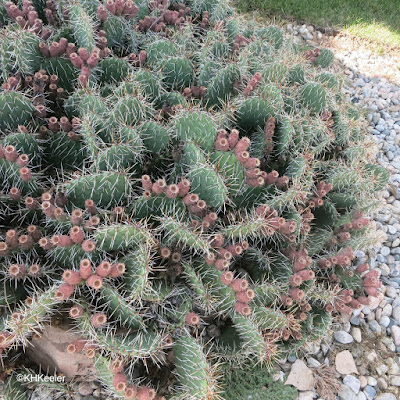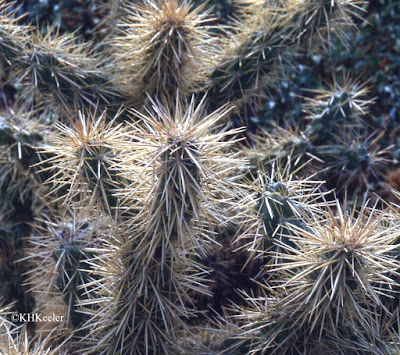 |
| A spine-covered cactus! |
Lots of plants are nasty.
Usually when plants are nasty, they are saying to animals "BACK OFF!"
Take the plant's eye view. You are growing happily in the sunshine and then some animal walks over and bites your top off.
Plants can't run from hungry animals, but they can fight.
Cacti are practically synonymous with spines. "Prickly as a cactus."
Cacti live in deserts. Water is in short supply and plants grow slowly. The loss of a branch to a jackrabbit might represent 3 years' growth.
Consequently the cactus has what I call a high "defense budget." It invests lots of its hard-won energy in spines to discourage animals from eating it. If the spines also discourage animals from brushing against it or stepping on it...all the better.
 |
| Prickly pear cactus, Opuntia, with fruits |
You'd think leaving spiny plants alone to be good idea. But what if you did not have enough to eat? The fruits on the cactus above are edible. The taste is pleasant although there isn't much fruit between the skin and the seeds. Could you gather them without being stabbed? Not easily. But if you were searching for food in a desert, you might think it worth while.
The Opuntia fruits are better defended than the photo shows. Each fruit has tiny spines all over its skin that, if you pick them, you'll be pulling out of your fingers or gloves for days. Gathering and weighing Opuntia fruits and then counting seeds for a botanical study some years ago was a really unpleasant experience. It ruined nice thick garden gloves, although the scientific results were interesting.
Many fine plants are spiny. Roses for example. I have a personal aphorism: "the roses always win." That means, no matter how carefully I garden around my roses, they still manage to grab me and draw blood.
 |
| Rose: see the prickles that draw blood |
My hawthorn is a hybrid without thorns, but the suckers coming up at the base have really nasty thorns. I have no photo of those because I didn't think I'd be interested in the suckers and clipped them off--carefully.
Spines, thorns and prickles are used as terms for nasty sharp plant parts and are formed by the plant from different tissues. Formally, spines are leaves. Highly modified, but leaves. Most cacti have no leaves but rather green, photosynthetic stems, and have turned their leaves into spines. Thorns are stems modified to be short (for a stem) and sharp. (I googled hawthorn tree thorns and got these pictures: link. I'm pretty sure they aren't all photos of hawthorn (Crataegus) but they are photos of thorns). Prickles are sharpened bits created from plant epidermis (the surface layer). Roses and raspberries have prickles. All three types can be large or small, viscious or trivial. Their function is usually to keep animals off, but some tropical vines use their thorns to climb (thorns help lodge them against tree branches) and dense spines on cacti reduce water loss from the plant surface.
 |
| Costa Rican tree with thorns: no monkeys allowed! |
The thistle is the emblem of Scotland (flower) because, according to legend, a Norse invading army, sneaking across Scotland barefoot, stepped on a thistle, yelled in pain and alerted the Scottish camp. The story is usually attributed to the war between Alexander II of Scotland and Haakon IV of Norway in 1263. The online stories all talk about Haakon's soldiers taking off their shoes to silently sneak up on Alexander's army. (link, link). Maybe. But medieval shoes were more like mocassins than modern army boots and so relatively quiet. Furthermore, people who normally wear shoes don't do very well barefoot on rough ground. Small stones and twigs hurt. And, consider arriving to surprise the other army and having to stop to put on your shoes. So, while I recognize that official and semi-official sources have for years been reporting that Haakon's surprise attack was ruined by a soldier with his shoes in his hand stepping on a thistle, I am doubtful. Scandinavians, sailing as viking raiders, sailed barefoot. It was much safer on a wet deck. Whether it was Haakon's army or earlier, I would argue that they didn't "take off their shoes" but rather, came off the ship without shoes. Probably the raiders' feet were tough, but the Scottish thistle prickles were tougher. Whatever the details, prickly thistles protected the Scots, which is why the thistle is their national emblem. (Another version of the story: link )
 |
| Thistle rosettes in the grass, Orkney, Scotland |
Comments and corrections welcome!
References
Evert, R.F. and S. E. Eichorn. 2013. Raven Biology of Plants. W. H. Freeman and Company, New York. print.
Oak Leaf Gardening: Thorns, spines and prickles. link Accessed 3/5/16
The studies that ruined my fingers and gloves.
Haridas, C.V., Keeler, K. H., and Tenhumberg, B. 2015. Variation in the local population dynamics of the short-lived Opuntia macrorhiza (Cactaceae), Ecology 96, 800-807.
Keeler, K.H. and B. Tenhumberg. 2011. Population dynamics of the western prickly pear cactus Opuntia macrorhiza (Cactaceae) The Southwestern Naturalist 56 (2): 147-153
Kathy Keeler
More at awanderingbotanist.com

No comments:
Post a Comment